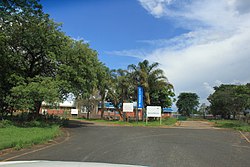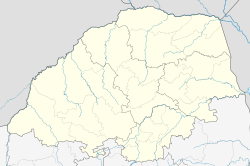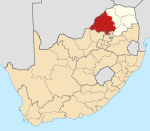Mokopane
Mokopane Potgietersrus | |
|---|---|
 | |
| Coordinates: 24°11′2″S 29°0′46″E / 24.18389°S 29.01278°ECoordinates: 24°11′2″S 29°0′46″E / 24.18389°S 29.01278°E ⧼validator-fatal-error⧽ | |
| Country | South Africa |
| Province | Limpopo |
| District | Waterberg |
| Municipality | Mogalakwena |
| Established | {{#property:P571}} |
| Area | |
| • Total | 75.13 km2 (29.01 sq mi) |
| Elevation | 1,130 m (3,710 ft) |
| Population (2011)[1] | |
| • Total | 30,151 |
| • Density | 400/km2 (1,000/sq mi) |
| Racial makeup (2011) | |
| • Black African | 66.7% |
| • Coloured | 0.7% |
| • Indian/Asian | 4.4% |
| • White | 27.6% |
| • Other | 0.6% |
| First languages (2011) | |
| • Northern Sotho | 46.5% |
| • Afrikaans | 27.8% |
| • English | 7.4% |
| • Tsonga | 4.4% |
| • Other | 13.8% |
| Time zone | UTC+2 (SAST) |
| Postal code (street) | 0600 |
| PO box | 0600 |
| Area code | +27 (0)15 |
Mokopane[2] (officially renamed from Potgietersrus in 2003), is a town in the Limpopo province of South Africa. The village Vredenburg was established by the Voortrekkers and renamed Piet Potgietersrust after the slain Voortrekker leader Piet Potgieter.
The towns name was changed to Mokopane in 2003 in honour of King Mgombane Kekana who defeated the voortrekkers at moordrift.
Two hours from Gauteng by road, the town acts as a getaway destination and as a stop-over for travelers en route to Botswana, Zimbabwe and Kruger National Park. The area is typical bushveld with many acacia trees and aloes, which display their beautiful blooms in June and July.
History[edit]
The historic and archaeologically significant Makapansgat caves are situated 15 km north of the town. Recovery of Homo habilis habitation has been made at these caves.[3]
Remains of Australopithecus africanus have also been found at the caves. The Arend Dieperink Museum portrays the history of the town, from the ape-man at Makapansgat, Bushmen paintings and early activities in the area up to the South African War and recent times.[4]
Culture[edit]
The stunning bushveld environment and influences from Northern Sotho, Ndebele, Tsonga, SeSotho, Afrikaans and English cultures give Mokopane a unique character. There are also ancient caves, the "Big Five", San rock paintings, curios, bushveld food and drinks such as biltong (dried meat) and mampoer (a potent alcoholic drink), tropical gardens and traditional dancing. In the adjacent township of Mahwelereng traditional lifestyles, set against the spectacular Waterberg, can be observed. Mokopane also offers outdoor activities ranging from hiking, camping and 4 × 4 trails to birding, angling and game viewing.[citation needed]
Economy[edit]
The economy of Mokopane used to be basically farming, until the opening of Anglo American's platinum mine. Currently the mine is the biggest contributor to the economy. Recently there has been interest displayed by other mining companies to start up, but community resistance around mining remains the main reason for the slow growth in mining.[citation needed] The Mokopane area is one of South Africa's richest agricultural areas, producing wheat, tobacco, cotton, beef, maize, peanuts and citrus. The area around Mokopane is rich in minerals with the mining of platinum, diamonds and granite.[citation needed]
See also[edit]
Notes[edit]
- ↑ 1.0 1.1 1.2 1.3 "Main Place Mokopane". Census 2011.
- ↑ Mokopane infosite, googlebattle.com; accessed 27 August 2014.
- ↑ Nick Norman and Gavin Whitfield, De Beers Consolidated Mines (2006) Geological Journeys: A Traveller's Guide to South Africa's Rocks and Landforms. Struik Publishing; ISBN 1-77007-062-1 Search this book on
 ., ISBN 978-1-77007-062-2 Search this book on
., ISBN 978-1-77007-062-2 Search this book on  .
.
- ↑ C. Michael Hogan, Mark L. Cooke and Helen Murray, The Waterberg Biosphere Archived 2012-04-29 at WebCite, Lumina Technologies, 22 May 2006.
External links[edit]
| Wikimedia Commons has media related to [[commons:Lua error in Module:WikidataIB at line 466: attempt to index field 'wikibase' (a nil value).|Lua error in Module:WikidataIB at line 466: attempt to index field 'wikibase' (a nil value).]]. |
- Mogalakwena municipality infosite[permanent dead link]; accessed 27 August 2014.
This article "Mokopane" is from Wikipedia. The list of its authors can be seen in its historical. Articles copied from Draft Namespace on Wikipedia could be seen on the Draft Namespace of Wikipedia and not main one.



